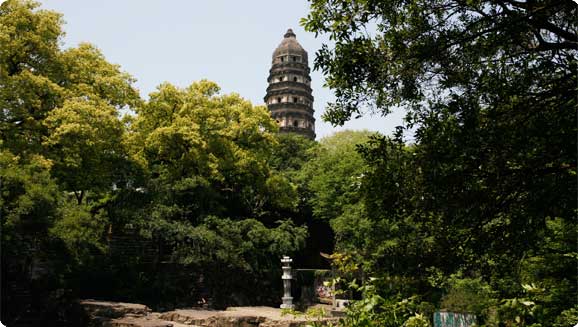Tiger Hill
虎丘

Tiger Hill is one of the most renowned tourist destinations in Suzhou, which is in fact a hillock about 30 meters in height. However, this tourist attraction site comprises nearly a dozen of historic and cultural relics to see, including Tomb of King He Lu, Yunyan Pagoda, Sword-testing Stone, the Thousand Men Rock, and the Sword Pond. The millennium-old Tiger Hill Yunyan pagoda stands on the top of the hill and is considered as the symbol of Suzhou.
Known also as Surging Sea Hill, many of these historic helices on Tiger Hill can be traced back over 2,500 years to the time when Suzhou was initially founded. The site is the final resting place for He Lu, the King of Wu State. During the Spring and Autumn Period (770 B.C – 476 B.C), the King died (600 B.C) in the war fought with the Yue State. His son buried him in the hill. Three days after funeral, a white tiger showed up and crouched on the grave, looking like guarding the tomb, hence the name to the hill.
Tiger Hill Pagoda (Yunyan Pagoda) is another legend for the historic site. It is said that the tower has been leaning since its completion in 959 - 961 A.D. The tower is 48 meter tall brick pagoda with seven stories and eight sides. It was constructed earlier and taller than the Leaning Tower of Pisa. It leans to the north by about 3.5 degrees. The tower was partially repaired in 1981 by the local government. Concrete piles have been driven into the ground around the pagoda in order to reinforce the foundation. Like many pagodas of the Tang and early Song periods, it is a stone imitation of earlier (or contemporary) wooden pagodas. The "brackets" and "lintels" carved on the surface are not structural, but decorative.
Sword Testing Stone and Sword Pond is another landmark of the historic site. It is said that King He Lu was a collector for the finest swords and he tested them upon this stone. The crevice thus left in the rock that is an evidence for the legend. It is believed that these swords were buried beneath the Sword Pond as the King’s funerary items. A thousand slaves, it was said, who built the tomb were buried alive with the deceased King upon completion of the tomb.
Wanjing Villa (Wanjing Shanzhuang) is simply one of Tiger Hill’s best attractions. The villa is a garden of potted landscapes and "bonzai-style" shrubs, covering an area of about 1,700 square meters. Some potted landscapes are quite small and some are not potted at all, but are small displays set up like miniature Suzhou gardens. All are intended to evoke images of marvelous mountain and forest scenery in the viewer's mind.
|



